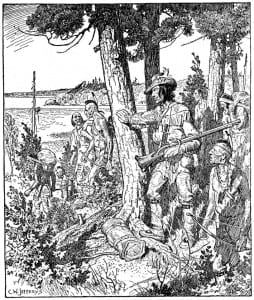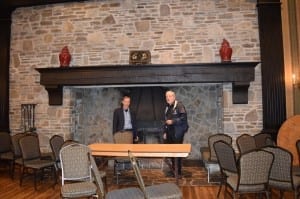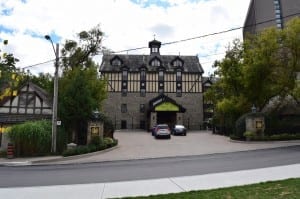The year 2015 marks the 400th anniversary of Étienne Brûlé’s expedition from Orillia to Lake Ontario in 1615
Updates:
Please note: Next planning meeting is at 12 Division at 10:00 am on March 23, 2015.
By way of other updates related to the year 1615 and thereabouts:
A March 12, 2015 Slate article is entitled: “Humanity Is a Geologic Force “as Earth-Changing as a Meteorite Strike”.
The article notes:
“The study’s first proposed start date, 1610, is haunting. During the 1500s, the authors argue, the effects of Europeans’ arrival at the Americas spread across the continents. What followed was a pandemic of smallpox, with up to 60 million casualties among the Native Americans—90 percent of the population. By 1610, massive reforestation pulled enough carbon dioxide from the atmosphere to show up in Antarctic ice cores, and perhaps initiate the so-called Little Ice Age cool-down in Europe.”
[End of excerpt]
A March 13, 2015 CBC article is entitled: “The Anthropocene: Was 1610 the start of the Age of Man? New epoch in Earth’s history in which humans are the dominant agent of change.”
[End of updates]
On Jan. 27, 2015, I attended a meeting at Division 12, Toronto Police Services. I owe thanks to Edith George for informing me of the meetings and the project.
The January 2015 meeting was concerned with preparations for the 400th anniversary celebrations of Étienne Brûlé’s expedition from Orillia to Lake Ontario in 1615. Many groups connected with the Humber River Watershed attended the meeting.

Étienne Brûlé at the mouth of the Humber River in 1615, 400 years ago as of 2015, accompanied by First Nations guides. Pen & Ink drawing, circa 1933, by C.W. Jefferys. Credit: Library and Archives Canada, Acc. No. 1972-26-1395. Copyright: Expired
Most recent meeting was on Feb. 23, 2015, 10:00 am, at 12 Division
I also attended a second meeting, Monday, Feb. 23, 2015 at 12 Division located at the corner of Trethewey and Black Creek Drive.
I’m pleased I had the opportunity to attend both of these meetings.
I was impressed with the energy and the sense of organization and clarity of thought that I encountered.
I’ve attended hundreds of meetings over the years on many topics. The two meetings that I’ve attended to date, in connection with the 400th anniversary of Étienne Brûlé’s travels in what we now call southern Ontario, have been of the highest calibre.
The official name of the project, as you may already know, is: Étienne Brûlé and Wendat Project.
A meeting was held today Feb. 23, 2015. Next planning meeting is at 12 Division, Toronto Police Services at 10:00 am on March 23, 2015.
Professional and public relations hikers
The project is concerned with commemoration of the journey to the mouth of the Humber River by Étienne Brûlé and Wendat First Nations warriors 400 years ago. Professional hikers travelling incredible distances per day are involved, as are canoeists who will paddle along parts of the Humber where canoes can travel. Various community groups will also stage their own events and activities.
I was pleased to learn that public relations hikers may also be conscripted, who would have time to talk with people while their professional counterparts are running through the woods, racing the clock, focused on their assigned task of covering huge distances as rapidly. From what I have gathered, these contemporary “runners in the woods” – that is, “coureurs des bois” – demonstrate a commendably high level of physical fitness.
Coordination of activities
The approach for the organizing of community-driven events, at stops all along the way, is (and this is a paraphrase of what I picked up):
“Just go ahead and do it; no need to ask permission from the lead organizers; but let’s ensure the activities are coordinated and information is shared; and take into account the carrying capacity of the City of Toronto parks (and parks elsewhere) and keep in mind the need for a coordinated approach to getting permits in place for activities in parks.”
There was initially a plan to forget about the mouth of the Humber River and Étienne Brûlé Park but in response to input from many people, the initial plan has been revised to include these areas.
The events on Sept. 11, 2015 (starting in Orillia), Sept. 12, (travelling further south), and Sept. 13 (at the southernmost area including around Old Mill Toronto and thereabouts) will be a great series of commemorative events.
Étienne Brûlé
Étienne Brûlé is credited with being the first European to set his eyes on Lake Ontario, 400 years ago this year.
Primary sources regarding his life is absolutely minimal, however. What I’ve encountered to date through online resources is heavy on conjecture and fantasy based on extrapolation from scanty evidence.
A resource that I do recommend is Champlain’s Dream: The Visionary Adventurer Who Made a New World in Canada (2008).
The study includes an overview of Étienne Brûlé’s activities in relation to Champlain’s project in North America. It also highlights recent research about Brûlé.
If you know of other recent resources by professional historians, please let me know.
I have an interest in the 400th anniversary for several reasons.
Brûlé Rooms at Old Mill Toronto

Jaan Pill (left) and Scott Munro check out fireplace at Brûlé Room C at Old Mill Toronto, during an early stage of planning for the Oct. 17, 2015 MCHS ’60s Reunion. We’ve since chosen the Humber Room at Old Mill as the venue for the event.
The Malcolm Campbell High School ’60s Reunion and Celebration of the ’60s was originally scheduled to take place in the Brûlé Rooms B & C at Old Mill Toronto on Oct. 17, 2015. For that reason, anything to do with Étienne Brûlé has been of interest to me. Subsequently, we’ve moved the reunion to the Humber Room at Old Mill and my focus has turned away from Étienne Brûlé to getting the final details in place for the reunion.
Jane’s Walk and the 400th anniversary celebration
Secondly, as a person who has been leading Jane’s Walks with Mike James for many years, it occurs to me that the 400th anniversary would be a great opportunity for the organizing of Jane’s Walks and heritage bike rides.
Further updates
A March 11, 2015 New York Times Magazine article is entitled: “My Saga, Part 2: Karl Ove Knausgaard’s Passage Through America.”
A passage from the article reads:
- We got into the S.U.V., and Peter started the engine and entered the GPS coordinates. The plan was to head north for Cheboygan and spend the night there. Soon we were out on the highway, smoking in our seats as Peter zigzagged slowly between the heavy, slow-moving semitrailers, the cabs of which resembled elaborate little houses. Ever since I landed in Cleveland the previous day, the landscape had been the same, a sort of centerless, semi-urban sprawl of highways, subdivisions, shopping malls, warehouses, gas stations and factories. If the Vikings really had left their settlements up in Newfoundland and explored the continent by following the rivers and lakes westward, as the Kensington Runestone’s presence in Minnesota suggested, it was in a world completely different from the one we drove through. I tried to imagine it, tuning out the sounds of the highway, the speed of the car, the concrete and the steel, but the place I then envisioned, a landscape untouched by man, was far too romantic to be true. The pre-Columbian Americans also had cities, they had roads, and some historians say that, at least before the diseases carried by Columbus and his successors wiped them out, there were more people here than in Europe. The really remarkable thing about the Vikings therefore wasn’t that they discovered America, but that they left it, almost without a trace.
[End of excerpt]
An Aug. 10, 2016 CBC article is entitled: “Popular theory on how humans populated North America can’t be right, study shows.”
An Aug. 22, 2016 Toronto Star article is entitled: “Sixties Scoop survivors’ day in court finally arrives Tuesday: Indigenous Canadians taken from their homes and their culture suing Ottawa, decades later, over the federal government’s duty to them.”
A Sept. 27, 2016 CBC article is entitled: “Prince William gets lesson in colonialism, cultural genocide at Black Rod ceremony: ‘The current Crown approach of deny and delay cannot continue,’ Grand Chief Ed John tells Prince William.”


The Dictionary of Canadian Biography Volume 1 (1000-1700). Brule, Etienne.
This is the best source on Brule and his life among the Hurons. An extensive bibliography follows the article on Brule, by Olgas Jurgens. The Dictionary of Canadian biography may be viewed online. See its web page above in your Website window.
If citing anything from the article please follow their request as follows: Cite This Article
Olga Jurgens, “BRÛLÉ, ÉTIENNE,” in Dictionary of Canadian Biography, vol. 1, University of Toronto/Université Laval, 2003–,
(There’s more to the citation which you can see in the online Dictionary of Canadian Biography…
Very good to know of this resource. It’s valuable that it can be accessed online.